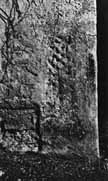Select a site alphabetically from the choices shown in the box below. Alternatively, browse sculptural examples using the Forward/Back buttons.
Chapters for this volume, along with copies of original in-text images, are available here.
Object type: Part of cross-shaft
Measurements: H. 76 cm (29.9 in) W. 49cm (19.3 in) D. 37 cm (14.6 in)
Stone type: Yellowish grey (10YR 8/2) oolite grainstone, of 0.3 to 0.5mm diameter ooliths; pellety in places. Ancaster Freestone, Upper Lincolnshire Limestone, Inferior Oolite Group
Plate numbers in printed volume: Ills. 128–9
Corpus volume reference: Vol 5 p. 141-142
(There may be more views or larger images available for this item. Click on the thumbnail image to view.)
A fragment from a large shaft decorated with interlace. Two decorated faces are visible. It is unclear what the original section of the shaft was, though unless it was very large indeed, it must have been nearly square.
A (now north facing): None of the borders of the decorated panel survive but the remains of the interlace indicate that the panel was at the base of the decoration on the shaft. The panel was clearly filled with an interlace grid, most of which is now only represented by the depressions marking the interstices.
B (now west facing): This face also has a panel of interlace grid in its lower parts. The panel is confined within a broad undecorated frame of rectangular section. Above the grid panel is a horizontal length of interlace or four-strand plait, again confined within an undecorated border of rectangular section.
Although this fragment has the characteristic rectangular border of the South Kesteven shaft group (Chapter V), it is considerably larger than the other known examples, of different stone type, and it seems to represent a shaft of more nearly square section. Within the county it has its strongest affinities with the cross-shaft at Brattleby (no. 1, Ills. 60–4, 66–7) – another product of the Ancaster quarries. Brattleby also has gridded panels and horizontal interlace within rectangular borders, like Creeton 4, and (also like Creeton 4) it is also of great scale and near-square section.



